Collecting workshop feedback may seem like a simple task — just ask what attendees think and wait for submissions. But is it really all there is to an evaluation process?
You should not expect good results if you rush headlong into creating a survey without properly thinking it through. There is a high chance that respondents will get frustrated at a poorly planned evaluation form and won't tell you anything useful. On the contrary, a well-designed and structured questionnaire can make your attendees actually reflect on their impressions and provide you with valuable insights for your future workshops.
So, how do you get feedback from a workshop with maximum effectiveness?
Table of contents:
Ask for feedback beforehand
Keep your goal in mind
Structure matters
Be careful with questions
Collect feedback effectively
Distribute thoughtfully
How can Workshop Butler help?
Ask for feedback beforehand
Say it out loud. During an event, you are the focus of it. That's why it's a great opportunity to tell your attendees personally how important their feedback is for you. A verbal explanation will be more effective than a written request.
And if you plan to send an evaluation form later, you can emphasize its significance one more time in the attached letter.

Be honest about time. Another thing you can inform your attendees about beforehand is how long this survey is going to take. If people know that it's just a couple of minutes, they will be less reluctant to open and answer it. And if it's a long list of questions, they will feel prepared and won't become annoyed that it takes longer than they expected.
Summary
Do not neglect preparatory work — explain the importance of constructive feedback and define the estimated time of completing a form.
Keep your goal in mind
"General impression about the event" is a field you most certainly come across in event survey templates. This universal question makes participants sum up their thoughts letting you know if this event was a success or you still have some work to do.
At the same time, it's very vague. Usually, attendees can outline a couple of traits they liked or disliked, but they don't elaborate on them, which means that you will have a hard time figuring out what affected their verdict. For this, you need more detailed questions. And here's the challenge.
An event has many aspects: content, materials, performance, organization. Naturally, trying to go into the details of each aspect would make your form painfully long.
Ask about everything. One way is to try and cover them all equally. For example, you can ask attendees to rate each topic and ask if they have any suggestions on how to improve it. If there was any problem, you will be able to pinpoint where. But it will only work if a student has formed a concrete opinion on this matter. If they haven't reached a conclusion yet, you will need to guide them to it.
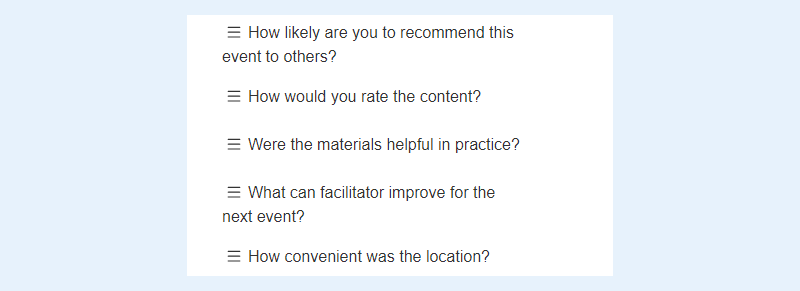
Choose one topic. Another approach is to prioritize what you want to learn more and focus on this aspect while briefly touching upon the rest of the topics. Generally, content and performance seem to be more significant factors to event success than organizational matters. So, if you have to choose, it would be more logical to ask whether attendees found learning engaging than how good coffee was.
If an event has been altered, you can shift the attention to these changes. For example, you have moved your events to a new location. Then it would be worth asking more about it to see if it was a good choice.
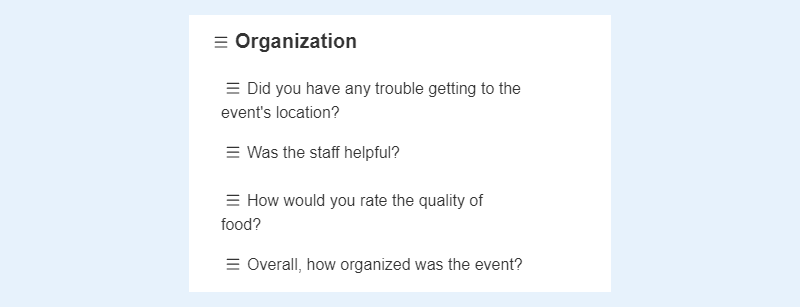
Summary
An evaluation form for a workshop is usually rather short so you should be careful with what you want to ask about. Define your objectives, then start writing questions.
Structure matters
The structure of a feedback form is one of those things that respondents don't pay any attention to, but which nevertheless influence their attitude.
A well-structured list of questions will help participants consolidate their feelings and maybe even realize something they haven't thought of before.
It's generally considered that detailed questions are better off for later. Diving straight into specifics might be confusing as you don't give respondents time to tune in.
General question first. Start with a general field like the one we mentioned earlier - How was your impression of the event?
Not only will this question allow your respondents to recall their experience, but answers to it will also show you raw emotions the workshop has left.

Details second. Once the tone is set, dissect an event into particular aspects and ask about them. You know your workshop better than anyone else so it shouldn't be too difficult for you to decompose it into logical parts.
Make sure that questions about one aspect stick together so that respondents won't have to mentally jump from one topic to another. It will negatively affect their concentration and won't allow them to fully immerse themselves.

Dividing your evaluation form into sections is the best approach in this case. Give each section a name (e.g. "Content" or "Facilitator's performance"), thus defining the common point of the following questions and reducing cognitive effort.

And rating in the end. You can wrap up your evaluation form with another general field asking attendees to rate your event. It will be easier for them to give it a rating based on the analysis they made when answering previous questions.

By structuring your form this way you will also be able to compare the immediate reaction of a student to an event and the conclusion they came to after reviewing it.
Summary
Precede questions about details with general inquiries giving respondents time to tune in to the topic. Allow better focus on each aspect by breaking fields into logical sections to receive thought-out replies.
Be careful with questions
Completing an evaluation form itself requires effort from respondents. Your job here is not just to ask whatever you need but also to keep it as light and easy as possible. If respondents have to rack their brains trying to understand your questions, it would significantly affect their disposition during form completion.
Stay concise and friendly. It's only natural to ask things in a simple way. If you have to explain something first, try breaking it down into several easy-to-follow sentences.
Unclearly-stated questions can lead to biased responses not reflecting the real impressions about a workshop.

Do not overcomplicate your language. Not only sentences, but language itself should be simple and clear as well, which means less jargon or formal terms. Even if your attendees belong to the same line of business, it does not mean that they know all the professional slang common in this field. And too formal language will make the tone of your questionnaire unnecessarily dry and boring, while you probably would like to maintain a friendly atmosphere.

Explain explicitly. The conversational tone of your form implies that the respondents are comfortable with giving you the information requested. If you are going to request sensitive information, show how you are going to handle it - either in the attached letter or in the text of the question.
For personal data, you can explain how it's protected and why you need it. And if this information can affect a person's position in their current workplace, emphasize that it's only for your research.
Keep it short. Even friendly questions might become irritating if there are too many of them. For a facilitator, each small detail about their workshop matters and they would be happy to know attendees' opinions about it. Unfortunately, the more questions you ask, the faster lowers respondents' concentration and the less inclined they become to continue. In other words, they reach the state of survey fatigue.
To prevent it, try not to go overboard with the number of questions. Setting an objective, like we described above, can help you with this. If you stick to a certain strategy, you can cut off unnecessary questions.
The ideal survey length would be 5 minutes or less. People would certainly appreciate it and be more generous with answers if they don't have to spend much time answering your questions.
Keep it balanced. Another thing to take care of is the balance of different question types. If your feedback form consists of 20 open-ended questions requiring respondents to come up with opinions on different matters, you could hardly expect detailed feedback as people value their mental resources no less than they value their time. Similarly, if there are too many multiple-choice or rating fields on the list, answering them will quickly turn tedious.
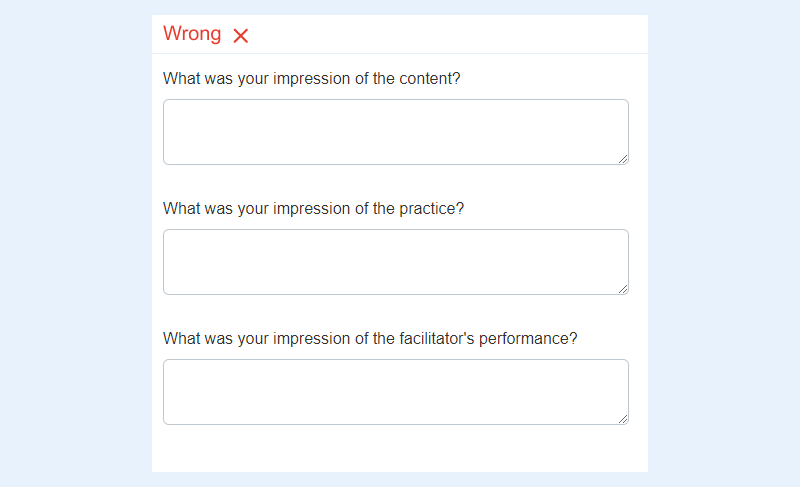
Including different question types in your evaluation form will help avoid such problems preventing respondents from becoming bored or frustrated.
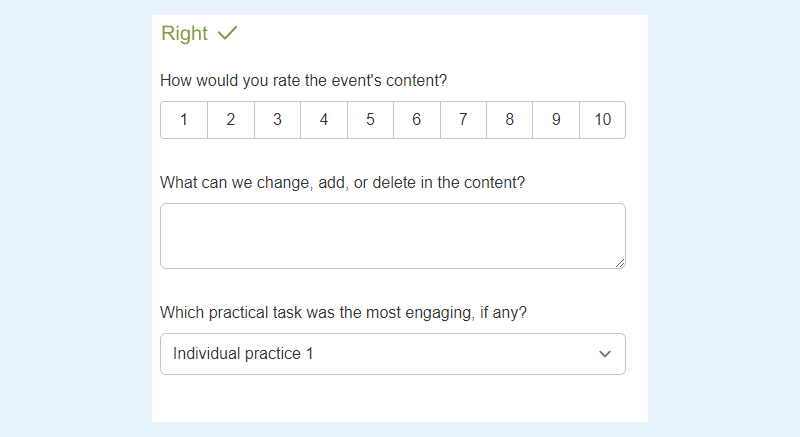
Ask in your attendees’ language. Speaking in the native language of your audience has obvious advantages both for you and your attendees. It significantly raises the chances to convey your questions right. It also gives your attendees more confidence in answering these questions and allows them to clearly express their thoughts.
If there are no language restrictions from the company that organized the event or other related parties, using your audience's language would be the best choice.
Summary
Maintaining a friendly conversational tone, using simple-phrased questions, and speaking in the attendees' native language will help respondents feel comfortable when filling the form. And a good balance of different types of questions will lower survey fatigue and yield more positive feedback.
Collect feedback effectively
Sometimes, forgetting a small detail might cause serious damage to the final results. You have carefully designed your questions and structured them well, but have you looked into form settings?
Know your settings. Different survey tools have different default settings which may or may not suit your purposes so it's important to check them before you start sending out evaluation requests.
Do you want to allow answer editing after the form has been submitted? Have you turned off form resubmission? Which email address will be used to send an evaluation request? These options are usually present in survey tools.
If you don't want submissions to be anonymous, you will need a way to collect the names. While some builders like Google Forms can track at least respondents' email addresses, with others you need to include the fields requesting relevant information in the form.
Test then test more. When all settings are finished, take one more step to be 100% sure you are good to go — test your form. First, try to fill it in yourself to check if it's configured exactly like you planned to.
Ask for peer review. If possible, ask someone else to test it. While you mostly will be paying attention to settings, other people will be able to tell how the structure and questions feel like. Are the questions comprehensible? Is the structure clear? Do respondents get frustrated or bored when filling it? As the form creator, you cannot evaluate these parameters objectively so you need help from others. Listen to the impressions of one, or preferably, several people and make adjustments if necessary.
Summary
Correct form settings are as important to the survey's success as well-composed questions. Double-check all options, then try answering your form yourself and ask others to do it to see if the questionnaire works the way you intended it to.
Distribute thoughtfully
The delivery method also plays its role in the completion rate and respondents' attitude. There are lots of ways to distribute an evaluation form among attendees:
- Hand out printed forms on site
- Send email
- Share on social media
- Use a QR code.
If you stick to traditional methods with paper forms, you can distribute and get replies back right after an event ends. On the plus side, everyone submits their feedback before leaving. On the downside, there might not be enough time for your attendees to collect their thoughts. If they are in a hurry or simply not ready to answer yet, they will just write whatever seems fitting for such a review.
Analyzing paper forms will pose another inconvenience. Going through all reviews and summarizing the results might be rather tedious. Add to this the fact that you have to decipher handwriting — and the process starts looking unreasonably time-consuming.
Email communication is probably the most popular form method. Request attendees' email addresses during registration and send them the link to a form.
What you should worry about is that mailing service algorithms might mark your message as spam by mistake and a recipient won't see it.
SMS is another way to gather feedback from your attendees. As our smartphones stay with us almost all the time, it's hard to miss a new message. Although not all people want to write feedback on their mobile devices and prefer a laptop instead, so SMS would not be the most convenient method for them.
Just like smartphones, social media has become a part of our daily lives. Why not use it for reaching out to your attendees and asking them to share their impressions of your event? The tricky part is that you need to make sure that attendees know where to look for the form and won't forget to do it.
QR codes are on the other side of the spectrum from traditional paper forms — they have become widespread relatively recently. All your attendees need to do is scan a code and the form will be downloaded on their phones.
The problem here is the same as with SMS — not everyone likes to write their feedback using a mobile device. Besides, unlike email or SMS, which has been with us for a long time and everyone has the necessary tools to handle them, to create a QR code, you will need to find software first.
Summary
With all said above, email proves itself as a reliable and time-tested method to send evaluation forms. The Email Address field is present in most registration pages and people generally have no problems with sharing it.
Although, the best method for each particular event may vary depending on the trainer's and attendees' preferences. Learn your audience and the tools you have at hand, then decide which way is the most effective.
How can Workshop Butler help?
Workshop Butler is the service that helps you streamline event management processes and handle them in the most efficient way. With it, you can solve some of the challenges in collecting evaluations.
Add templates for different purposes. WSB allows users to create and save evaluation form templates for different events, then applies these templates correspondingly. If you have just started a new event and would like to know more about its content, you can design a template specifically for this event, while using a different template for a different event you have been running for a long time already.

Select appropriate question types, combine them into sections, and translate them into different languages. Our builder has several question types: open-ended questions, close-ended questions, and ratings. Switch between them to keep respondents engaged and group fields into sections to make your form more structured. You can add translation to several languages for each question and section.
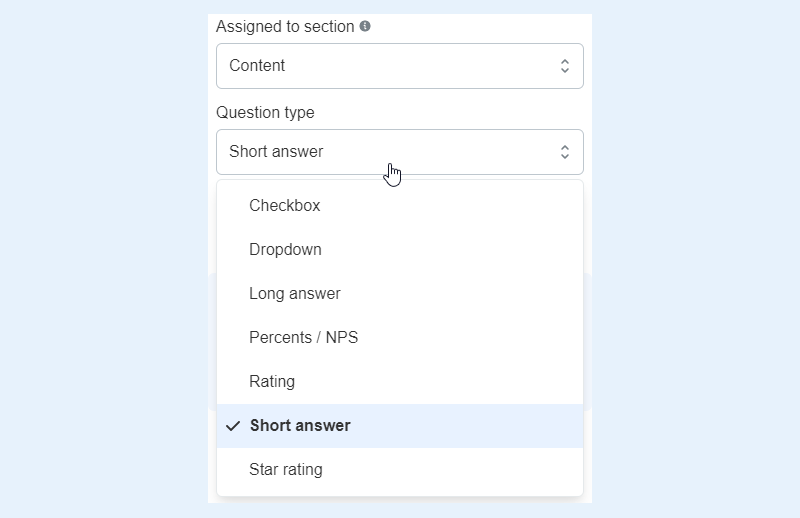
Request an evaluation in email. Email is the most common and convenient way to request an evaluation so we employ it in our system. WSB can automatically send feedback requests and reminders from your own domain without involving you in this process. Or you can distribute the form yourself by simply choosing attendees from the mailing list.

Write your own evaluation request. You can change the default text and emphasize the importance of feedback or simply thank attendees for participation in your own manner. Furthermore, each message is personalized as WSB pulls up the data from a registration form when creating an evaluation request. People definitely love letters addressed to them directly more than impersonal messages.
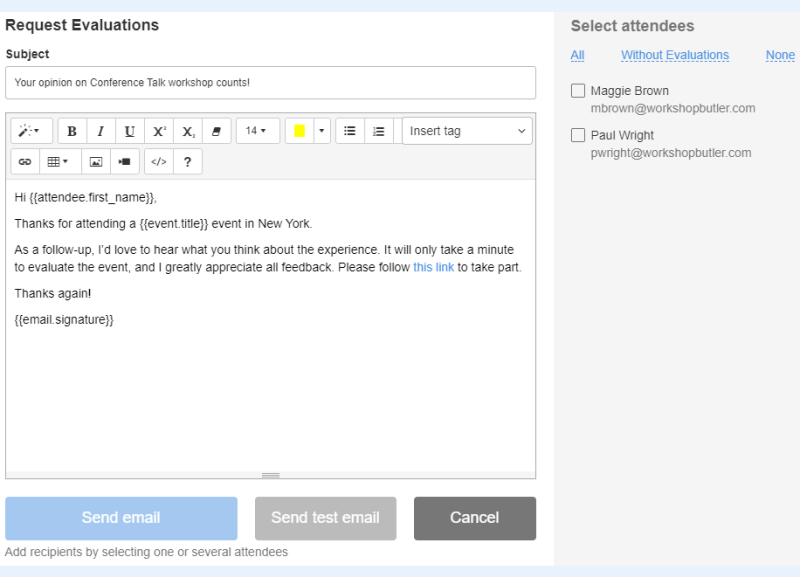
Know exactly whom you receive feedback from. As we have already mentioned, WSB makes use of the information received during registration. It means that you don't have to worry that you forgot to ask attendees' names or email addresses. If you have requested this information in your registration form, the system stores it and adds new evaluations received from this attendee to their profile.

WSB cannot tell you how good your questions are or choose the most effective question order, but it can free your time for doing it by taking small administrative tasks upon itself.
Learn more about tools for collecting event feedback in Workshop Butler, how they can save your time and provide you with effective and structured data for your future workshops.

